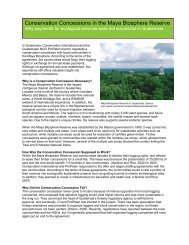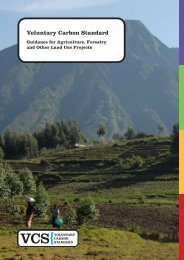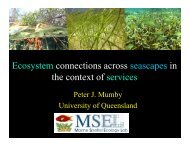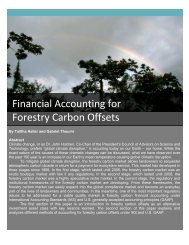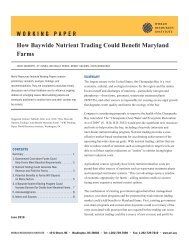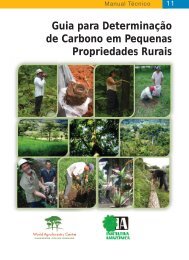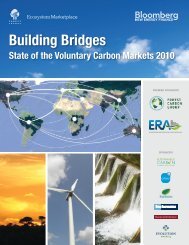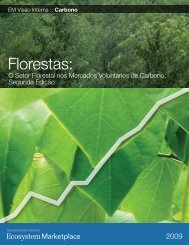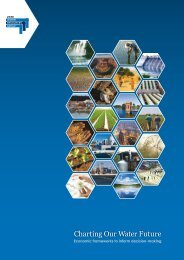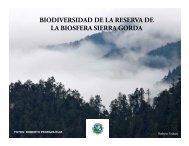STATE WILDLIFE ACTION PLANSBox 2. State Wildlife Action Plans: Eight Required ElementsCongress identified eight required elements <strong>to</strong> be addressed in each state’swildlife action plan (technically called a “comprehensive wildlife conservationstrategy”). Congress also directed that <strong>the</strong> plans must identify and be focusedon <strong>the</strong> species in greatest need <strong>of</strong> conservation yet address <strong>the</strong> full array <strong>of</strong> wildlifeand wildlife-related issues.1. Information on <strong>the</strong> distribution and abundance <strong>of</strong> species <strong>of</strong> wildlife,including low and declining populations as <strong>the</strong> state fish and wildlife agencydeems appropriate, that are indicative <strong>of</strong> <strong>the</strong> diversity and health <strong>of</strong> <strong>the</strong>state’s wildlife – termed “species <strong>of</strong> greatest conservation need”;2. Descriptions <strong>of</strong> <strong>the</strong> extent and condition <strong>of</strong> habitats and community typesessential <strong>to</strong> conservation <strong>of</strong> species <strong>of</strong> greatest conservation need;3. Descriptions <strong>of</strong> problems that may adversely affect <strong>the</strong> species or <strong>the</strong>irhabitats, and priority research and survey efforts needed <strong>to</strong> identify fac<strong>to</strong>rsthat may assist in <strong>the</strong> res<strong>to</strong>ration and conservation <strong>of</strong> <strong>the</strong>se species andhabitats;4. Descriptions <strong>of</strong> <strong>the</strong> proposed conservation actions for conserving <strong>the</strong> identifiedspecies and habitats and priorities for implementing such actions;5. Proposed plans for moni<strong>to</strong>ring <strong>the</strong> species and <strong>the</strong>ir habitats, moni<strong>to</strong>ring<strong>the</strong> effectiveness <strong>of</strong> <strong>the</strong> conservation actions, and adapting <strong>the</strong>se conservationactions <strong>to</strong> respond appropriately <strong>to</strong> new information or changing conditions;6. Descriptions <strong>of</strong> procedures <strong>to</strong> review <strong>the</strong> plan at intervals not <strong>to</strong> exceedten years;7. Plans for coordinating <strong>the</strong> development, implementation, review, and revision<strong>of</strong> <strong>the</strong> plan with federal, state, and local agencies and Indian tribesthat manage significant areas <strong>of</strong> land and water within <strong>the</strong> state or administerprograms that significantly affect <strong>the</strong> conservation <strong>of</strong> identified speciesand habitats; and8. Plans for broad public participation as an essential element <strong>of</strong> developingand implementing <strong>the</strong>se plans, carrying out conservation projects during <strong>the</strong>development <strong>of</strong> <strong>the</strong>se plans, and conserving <strong>the</strong> species in greatest need <strong>of</strong>conservation.Adapted from: Teaming With Wildlife. “State Wildlife Action Plans: Eight Required Elements.” http://www.wildlifeactionplans.org/pdfs/eight_elements_handout.pdf(among o<strong>the</strong>rs), all have active banking programs andmany active or pending banks (at least 47 in Virginiaalone), but none <strong>of</strong> <strong>the</strong>ir plans even mention banking.California was ano<strong>the</strong>r surprising example. Its formalconservation banking policy in 1995 has fostered <strong>the</strong>development <strong>of</strong> a thriving conservation banking industry,including wetland mitigation banks and endangeredspecies conservation banks, among o<strong>the</strong>rs. Yet,<strong>the</strong> California plan makes only passing references <strong>to</strong>banking in its appendices.The Oregon Plan is alone in providing an extensive discussion<strong>of</strong> banking. Among o<strong>the</strong>r things, <strong>the</strong> chaptersummarizing <strong>the</strong> state’s overall strategy recommendsthat <strong>the</strong> State “[e]xpand conservation banking <strong>to</strong>a statewide approach.” In explaining this recommendation,<strong>the</strong> plan states that “<strong>Conservation</strong> bankscould be expanded for broader uses at larger scales.As an example, <strong>the</strong> Willamette Partnership is forminga conservation banking system in <strong>the</strong> WillametteBasin that <strong>the</strong>y hope will serve as a pro<strong>to</strong>type forOregon.” 64 In addition, <strong>the</strong> chapter concludes with alist <strong>of</strong> “first steps in achieving <strong>the</strong> goals” <strong>of</strong> <strong>the</strong> plan.Among <strong>the</strong>se is <strong>the</strong> following: “In coordination withvarious state agencies (i.e., Oregon Department <strong>of</strong>Transportation, Oregon Department <strong>of</strong> State Lands,Oregon Department <strong>of</strong> Energy), explore options forestablishing regional ‘conservation banks’ that couldbe used <strong>to</strong> meet mitigation requirements in a mannerthat benefits Strategy Species and <strong>Habitat</strong>s.” 65The state significantly expands upon <strong>the</strong> above recommendationin <strong>the</strong> section designated “Stepping Downfrom Statewide <strong>to</strong> Local.” The drafters <strong>of</strong> <strong>the</strong> Oregonplan clearly had a sound grasp <strong>of</strong> banking, includingboth its potential and its limitations:A statewide system <strong>of</strong> conservation banks wouldprovide a <strong>to</strong>ol for implementing this <strong>Conservation</strong>Strategy and for achieving statewide habitat conservationgoals. Working at <strong>the</strong> state level allows <strong>the</strong>banking system <strong>to</strong> be flexible by receiving mitigationfees and voluntary investments from parts <strong>of</strong><strong>the</strong> state where habitat impacts occur and by developingconservation banks in areas with <strong>the</strong> highestpriority conservation needs. The <strong>Conservation</strong>Strategy recognizes <strong>the</strong>re are ecologically significantvalues in both rural and urban areas and prioritizationregarding where <strong>to</strong> invest in conservationbanks should take <strong>the</strong>se values in<strong>to</strong> account. Thestatewide conservation banking system could allow<strong>of</strong>f-site (away from <strong>the</strong> impact) banking perhapswith an ecoregion focus while o<strong>the</strong>r banks could becloser <strong>to</strong> <strong>the</strong> project site (same or nearby water-64 Oregon Department <strong>of</strong> Fish and Wildlife. February 2006. “TheOregon <strong>Conservation</strong> Strategy.” p. 25.65 Oregon Department <strong>of</strong> Fish and Wildlife. February 2006. “TheOregon <strong>Conservation</strong> Strategy.” p. 31.22 Environmental Law Institute
STATE WILDLIFE ACTION PLANSshed). Currently, state and federal requirements formitigation banks do not always provide flexibility.<strong>Conservation</strong> banks can be in-kind (same or similarhabitat type) in order <strong>to</strong> replace lost ecosystemservices. In many cases it may be desirable <strong>to</strong> makeout-<strong>of</strong>-kind (different habitat type) investmentswhen <strong>the</strong>re is opportunity <strong>to</strong> trade a more commonhabitat type for an extremely rare one such asWillamette Valley prairie. The statewide conservationbanking system would need <strong>to</strong> balance <strong>the</strong>benefits <strong>of</strong> conserving <strong>the</strong> highest priority habitats(regardless <strong>of</strong> location and type <strong>of</strong> impact) with<strong>the</strong> benefits <strong>of</strong> replacing impacted habitat with <strong>the</strong>same habitat and in close proximity.Careful planning, coordination and managementwill be needed <strong>to</strong> create an effective, flexiblestatewide conservation banking system. Significantcoordination will be needed between agencies thatset conservation goals, potential and actual conservationbank owners and managers, and agencies ororganizations that contribute mitigation fees or voluntaryfunds <strong>to</strong>ward credits. One or more agenciesor organizations would need <strong>to</strong> take responsibilityfor coordination, program management, habitatmanagement, measuring performance, moni<strong>to</strong>ring,reporting, and fiscal management. 66The discussion in <strong>the</strong> Oregon Plan references a number<strong>of</strong> <strong>the</strong> most important and challenging issues related<strong>to</strong> banking, most <strong>of</strong> which are explored in greaterdetail later in this report. These include issues related<strong>to</strong>: using banks in one area <strong>to</strong> <strong>of</strong>fset impacts that occurin more distant areas, <strong>of</strong>fsetting impacts <strong>to</strong> a particulartype <strong>of</strong> resource by conserving a different type <strong>of</strong>resource, and dealing with challenges related <strong>to</strong> <strong>the</strong>management <strong>of</strong> bank sites, <strong>the</strong> moni<strong>to</strong>ring <strong>of</strong> bank performance,and <strong>the</strong> coordination <strong>of</strong> disparate parties.Only two plans, New Mexico and Colorado, specificallymention a type <strong>of</strong> banking known as “grass banking.”The New Mexico Plan includes <strong>the</strong> followingconservation action for four <strong>of</strong> its several priorityecoregions: “work with land management agencies,private land managers, and <strong>the</strong> agriculture industry <strong>to</strong>identify and promote grazing systems on rangelandsthat ensure long-term ecological sustainability andintegrity and are cost effective for lives<strong>to</strong>ck interests.Such practices may include … promoting ‘grass banking’opportunities that allow degraded rangelands <strong>to</strong>recover.” Whereas grass banking is listed as twelfthamong twelve for <strong>the</strong> Arizona-New Mexico MountainsEcoregion, it is <strong>the</strong> <strong>to</strong>p action for <strong>the</strong> ChihuahuanDesert Region, and <strong>the</strong> third highest (among eighteen)for <strong>the</strong> Western Great Plains Short-Grass PrairieEcoregion. This suggests that <strong>the</strong> drafters <strong>of</strong> <strong>the</strong> NewMexico Plan gave careful thought <strong>to</strong> <strong>the</strong> potential benefits<strong>of</strong> grass banking and where those benefits weremost needed.The absence <strong>of</strong> any mention <strong>of</strong> banking in <strong>the</strong> majority<strong>of</strong> plans, and <strong>the</strong> very brief mention <strong>of</strong> it in most o<strong>the</strong>rs,presents a challenge for taking fuller advantage<strong>of</strong> <strong>the</strong> plans in <strong>the</strong> banking context. The paucity <strong>of</strong>discussion <strong>of</strong> banking in <strong>the</strong> various plans might meanthat <strong>the</strong> drafters <strong>of</strong> those plans were relatively unfamiliarwith <strong>the</strong> <strong>to</strong>pic. On <strong>the</strong> o<strong>the</strong>r hand, it could bethat plan drafters were quite familiar with banking,but did not think it was a useful <strong>to</strong>ol <strong>to</strong> achieve <strong>the</strong>plans’ goals. Still o<strong>the</strong>r explanations are possible aswell. Given that uncertainty, this report tries <strong>to</strong> reacha broad audience. It provides a basic understanding<strong>of</strong> banking, so that those who have been previouslyunfamiliar with it can better evaluate its potential utilityfor <strong>the</strong>ir plans. At <strong>the</strong> same time, this report seeks<strong>to</strong> be more than just a primer on banking by <strong>of</strong>feringanalysis that should be helpful <strong>to</strong> those who alreadyhave a solid grasp <strong>of</strong> <strong>the</strong> subject.66 Oregon Department <strong>of</strong> Fish and Wildlife. February 2006. “TheOregon <strong>Conservation</strong> Strategy.” p. 82.<strong>Design</strong> <strong>of</strong> U.S. <strong>Habitat</strong> <strong>Banking</strong> <strong>Systems</strong> <strong>to</strong> <strong>Support</strong> <strong>the</strong> <strong>Conservation</strong> <strong>of</strong> Wildlife <strong>Habitat</strong> and At-Risk Species 23



